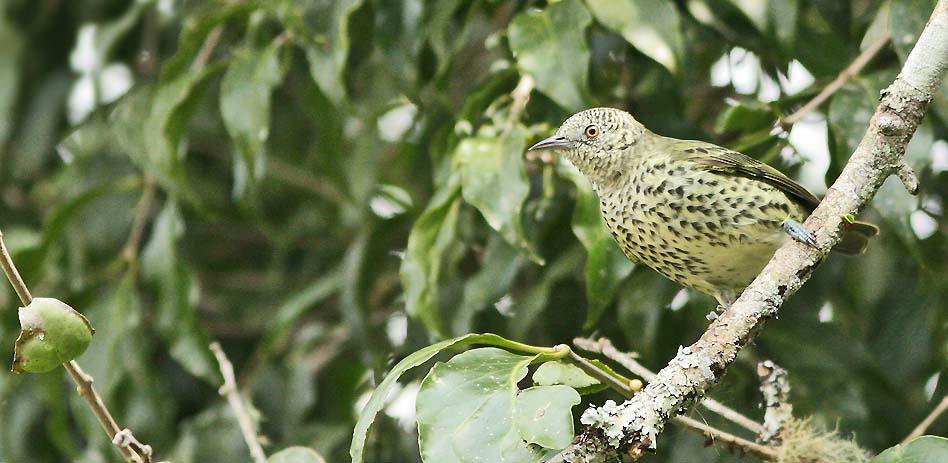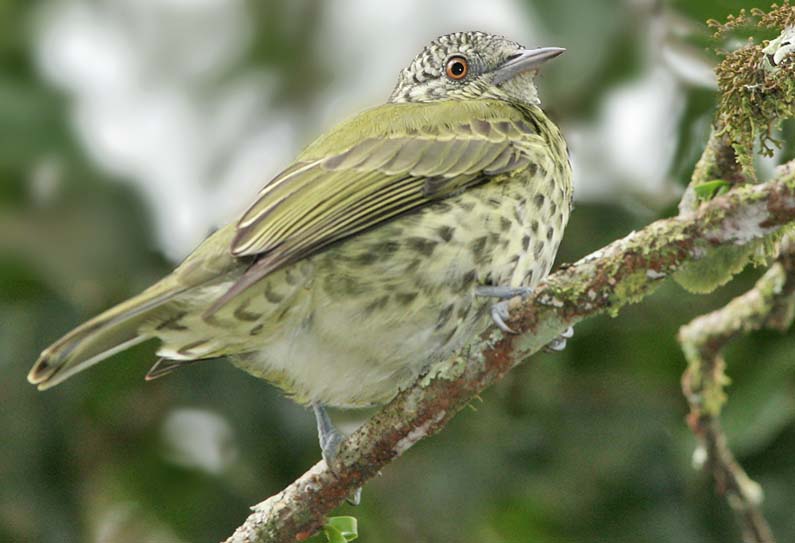
a web page by Don Roberson |
SHARPBILL Oxyruncidae |
|
Its relationship to other suboscines was always uncertain, and traditionally it was placed in its own family, the Oxyruncidae. Snow (2004), in HBW, said "The anatomical characters that have been studied do not provide clear evidence of its relationships, and the species' unique bill shape is considered phylogenetically uninformative. In some respects, such as the concealed crown patch and the male's modified outermost primary, the Sharpbill resembles the tyrannids, and certain other features, including the structure and musculature of the syrinx, support such a relationship. On the other hand, the general body proportions, the singing behavior and the fact that the young are fed by regurgitation point to a relationship with the cotingas.... For the time being, it is probably best to treat the Sharpbill as a cotinga, but the taxon clearly remains in need of further study." |
Genetic evidence has been equivocal. Based on initial biochemical evidence, Dickinson (2003) put it in the the Cotingidae. The on-line South American Checklist Committee initially did so as well (2004) but more recently (2007) the SACC again made it a monotypic family. Ericson et al. (2006) cite strong molecular and morphological reasons that it belongs with the Tityridae; at a minimum, it is a sister to the others in this family, and they are its closest living relatives. In my previous edition I wrote that "Since the divergence of this taxa is not nearly as ancient as most (all?) others placed in monotypic families, I feel it is best to consider it within the Tityridae," with which some at suggested a relationship, as with the Schiffornis group (e.g., Prum & Lanyon 1989). More recently (2011), the on-line SACC taxonomy states, in part: "The relationships of Sharpbill have been controversial and remain unresolved. It has been included in the Cotingidae, Tyrannidae, or Tityridae. Chesser (2004b) found no strong support for any of these relationships, and Ohlson et al. (2007) found strong evidence against inclusion of Oxyruncus in the Cotingidae. Thus the "traditional ranking of Oxyruncus as a monotypic family was the best portrayal of our understanding of its relationships at that time." Tello et al. (2009) have confirmed the distinctiveness of Oxyruncus relative to the traditional family groupings but found that the tyrannid genera Onychorhynchus, Myiobius, and Terenotriccus grouped with Oxyruncus, and proposed that these genera be moved to Oxyruncidae." No action has yet been taken by SACC on that idea; IOC places it among the Tityridae, although with the three associated 'flycatcher' genera. Given this continuing uncertainty, it seems best to again tentatively elevate the Oxyruncidae as a Family, so that birders continue to be aware of its uniqueness, but perhaps with the understanding that the Family may, in due course, be expanded to include Royal Flycatcher and various other "flycatchers". Those that tentatively might be included are:
Odds are that if you've birded South America, you've seen one of those, so it is possible that, in time, seeing the Sharpbill will lose its special appeal. Yet, it is a decidedly cool bird. |
 |
For starters, the vocalization of male is disturbing. It is a sharp whistle, starting on a high frequency, and then descends over a full octave, a sound that has an uncanny resemblance to a falling bomb. The species is rather poorly known and is often hard to observe. Its distribution is oddly fragmented, but why this is so is not understood. Males may hold closely adjoining territories — like an "exploded lek" (Snow 2004) — but for reasons unknown they don't display the concealed red crest. All in all, an odd bird of uncertain affinities that is a rewarding treat in its own right. |
Photos: The two photos of Sharpbill Oxyruncus cristatus were taken at Intervales State Park, Brazil, on 1 Aug 2010. Photo © D. Roberson; all rights reserved. Bibliographic note: There is no "family book" per se, but a good introduction to this species, with a good photo, is in Snow (2004). Literature cited:
|
 The Sharpbill
(left) is an enigmatic fruit-eater in many isolated populations
throughout the Neotropics — from Costa Rica to Venezuela, Peru, and
southeast Brazil/northeast Argentina.
The Sharpbill
(left) is an enigmatic fruit-eater in many isolated populations
throughout the Neotropics — from Costa Rica to Venezuela, Peru, and
southeast Brazil/northeast Argentina.